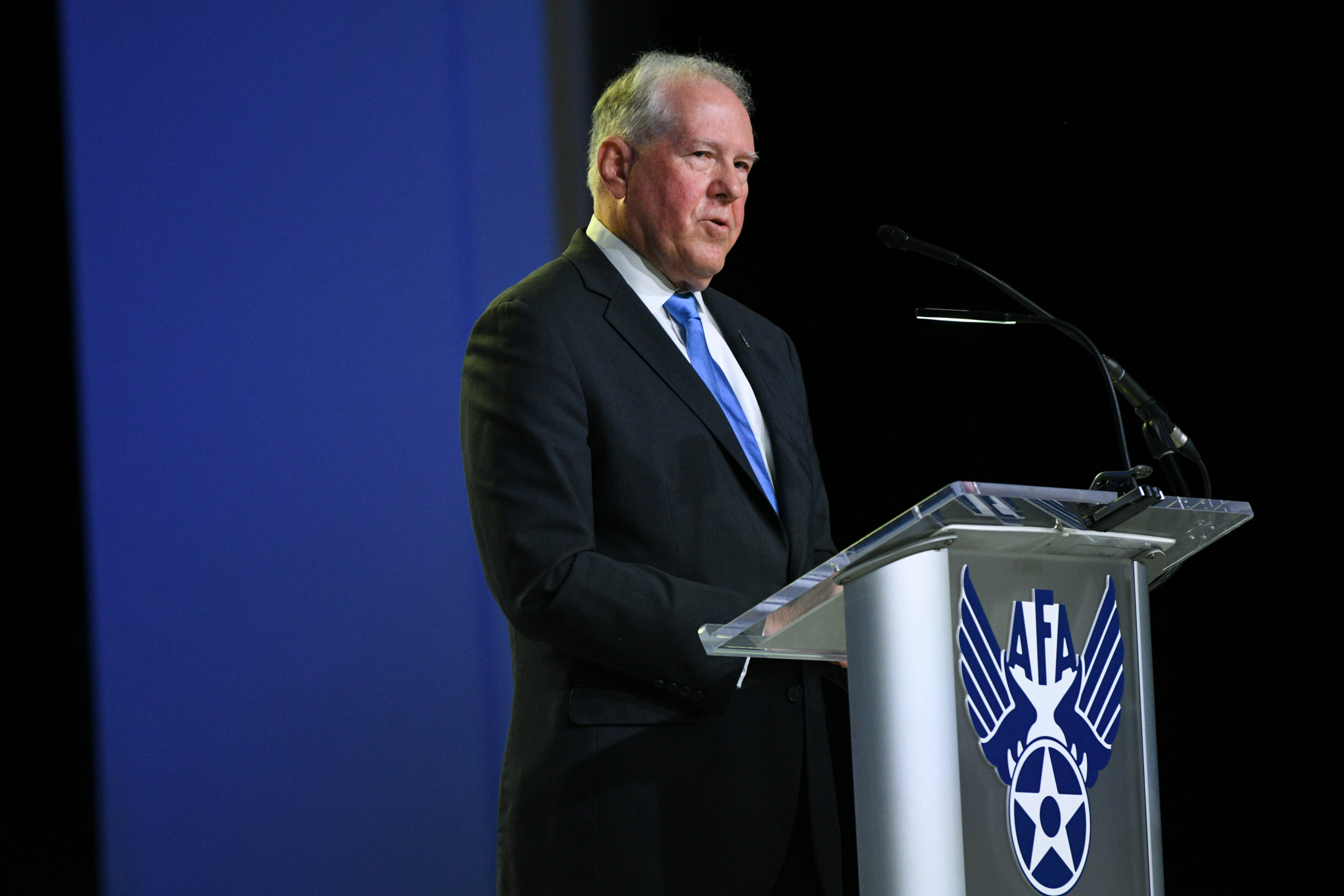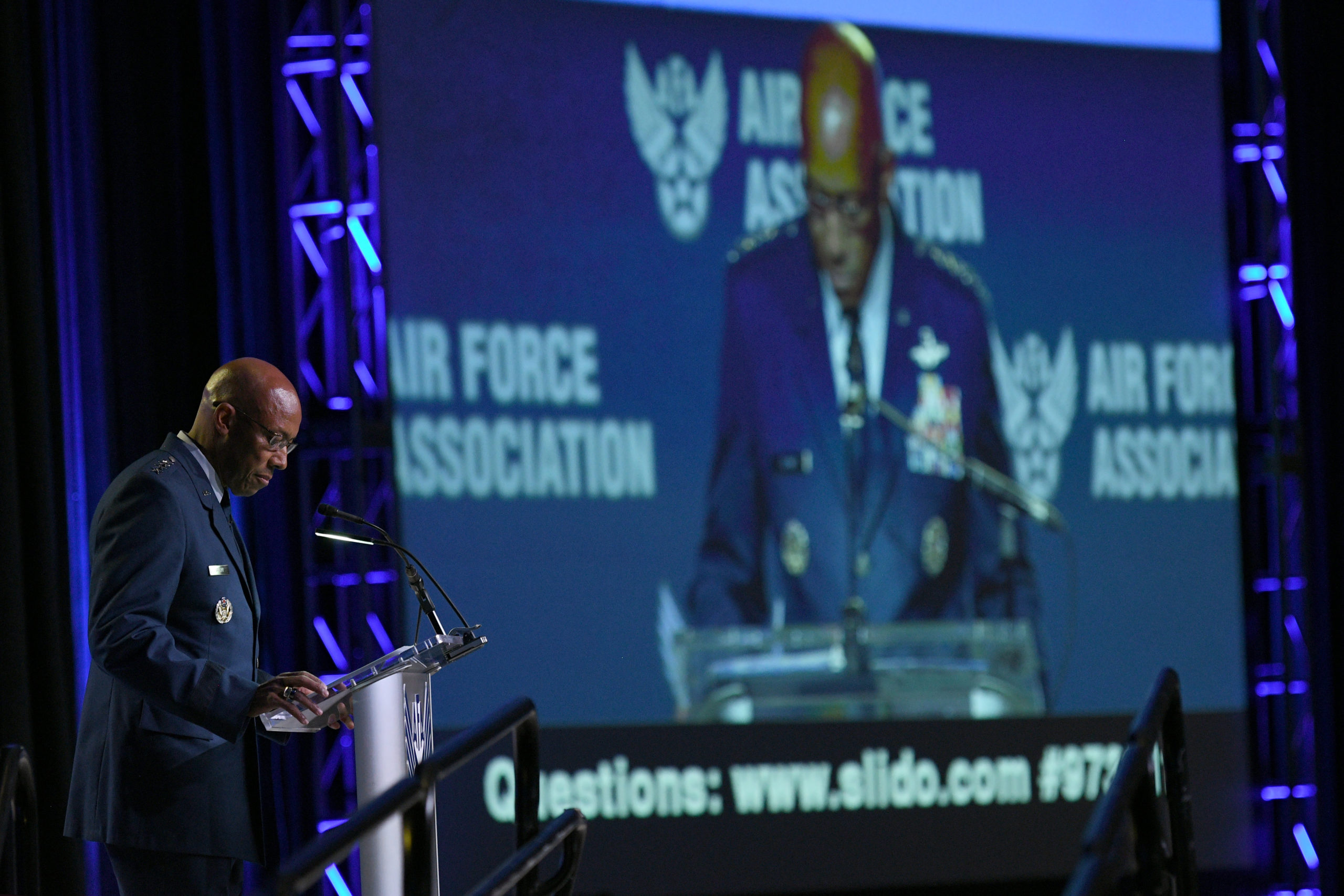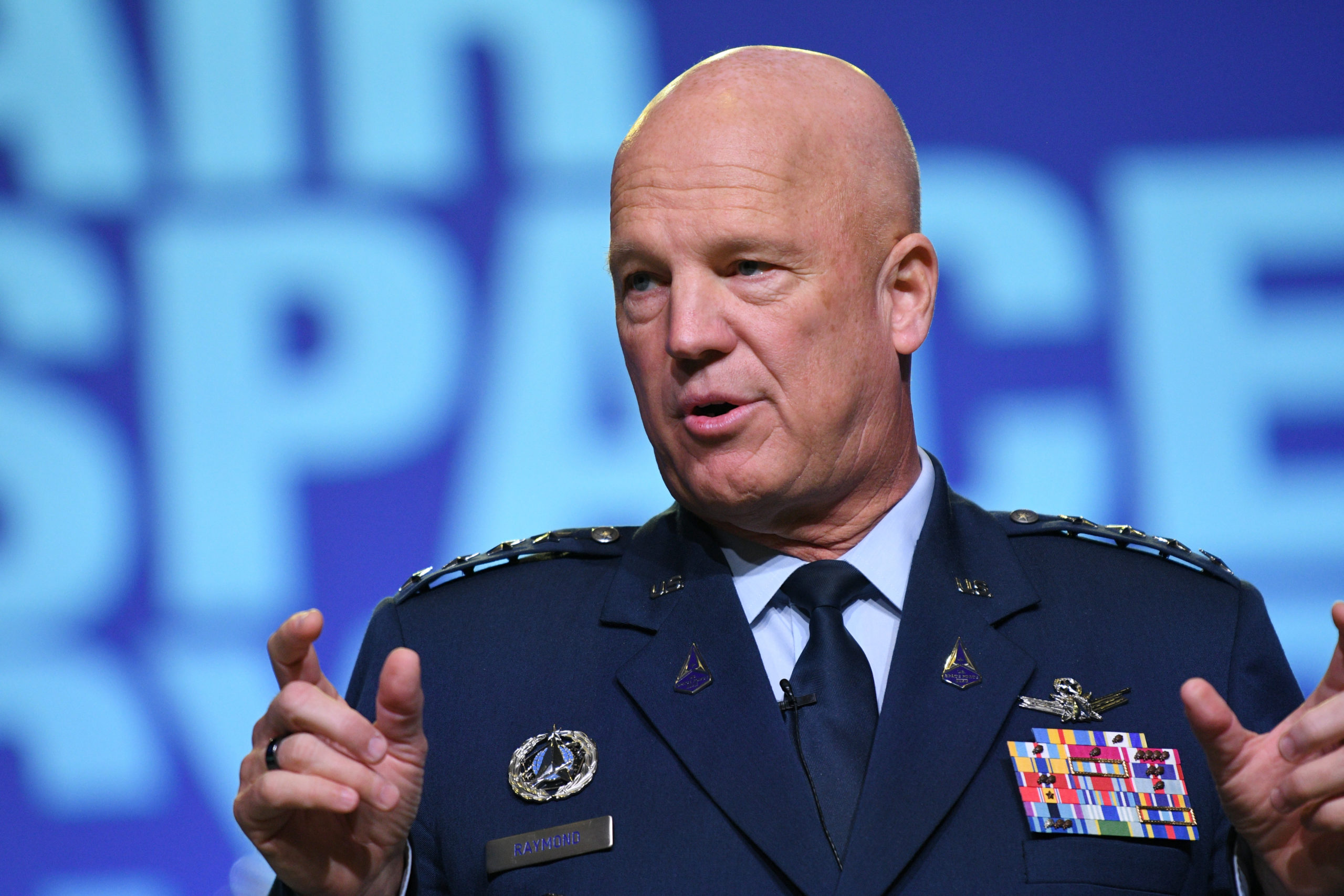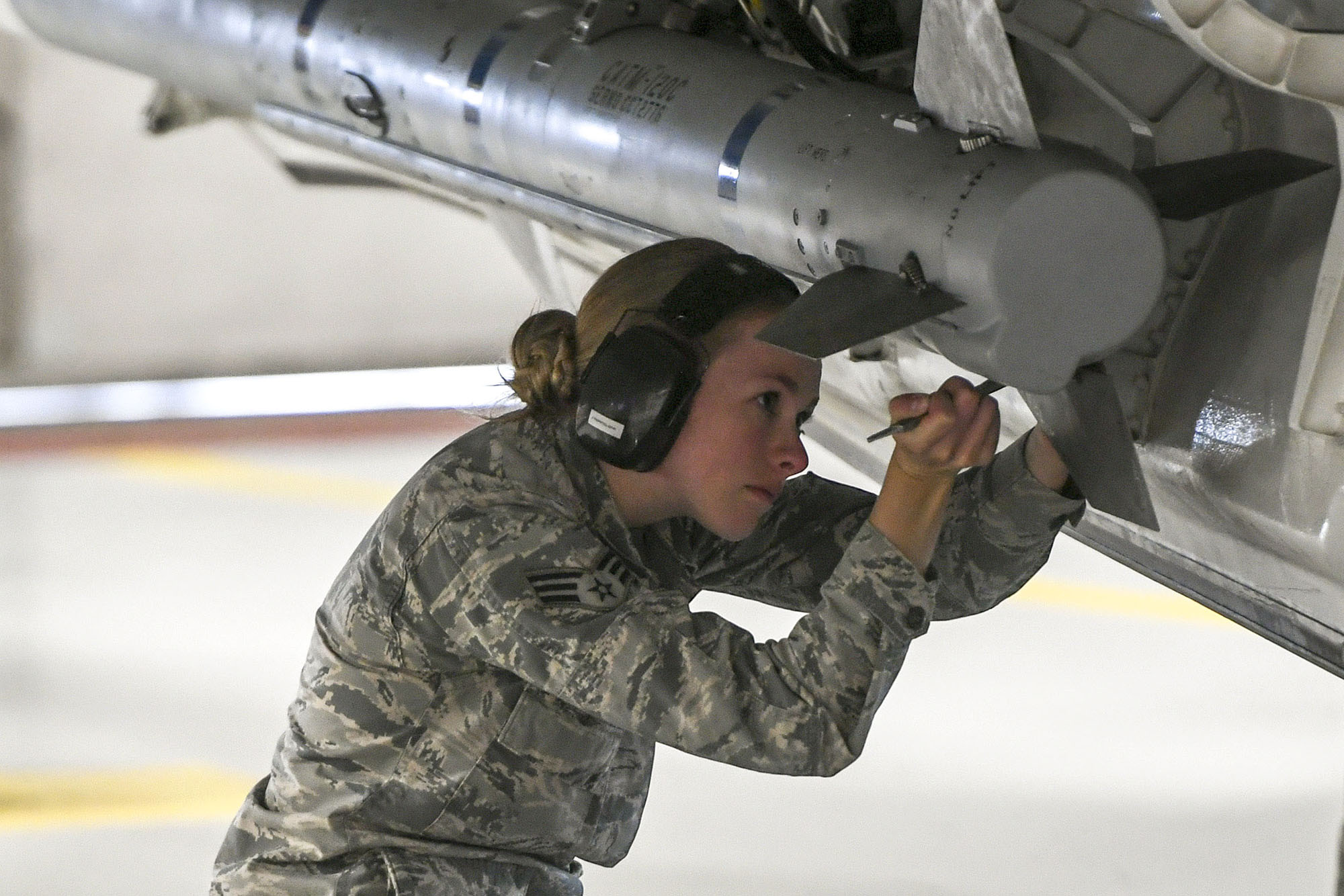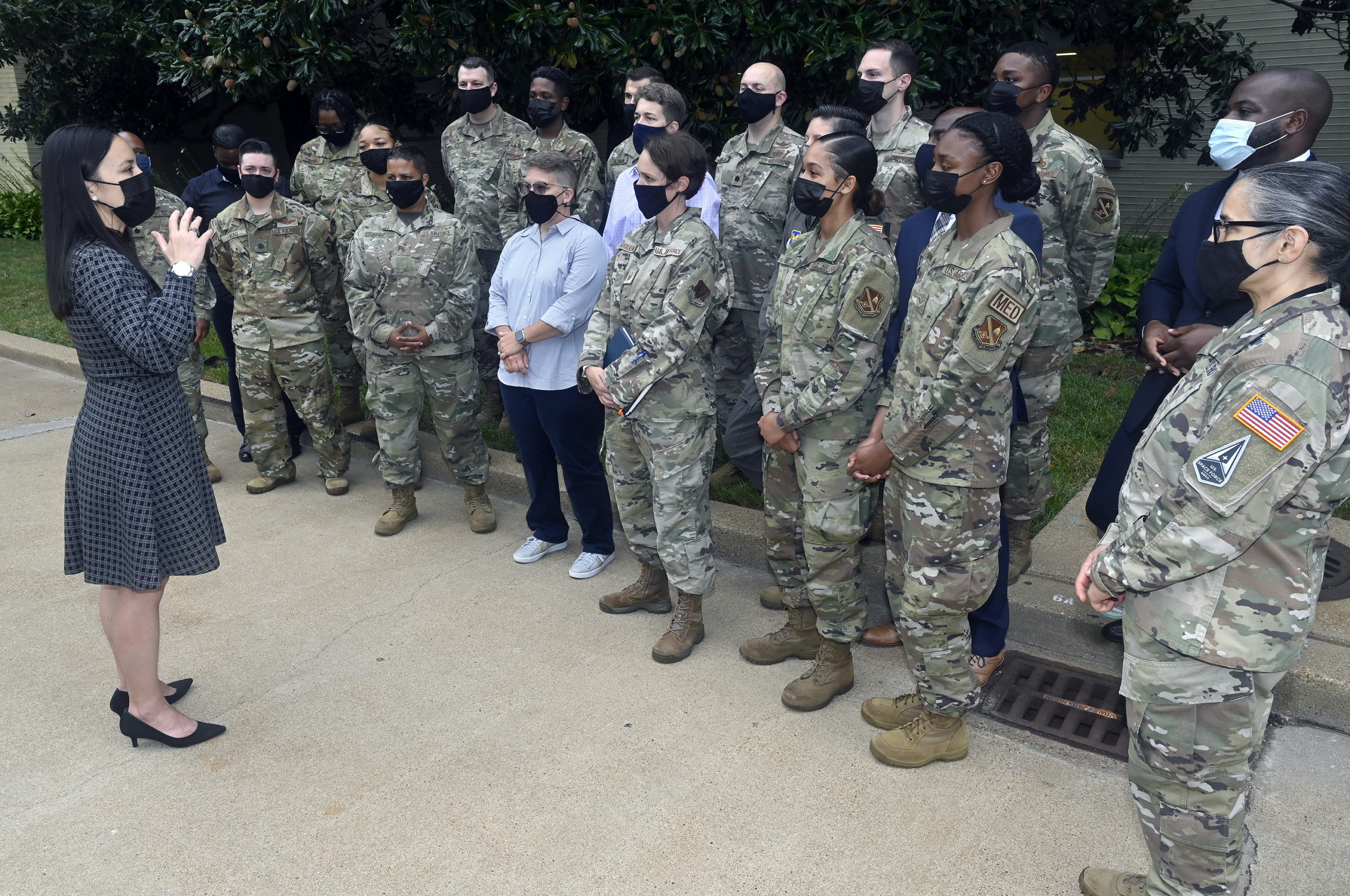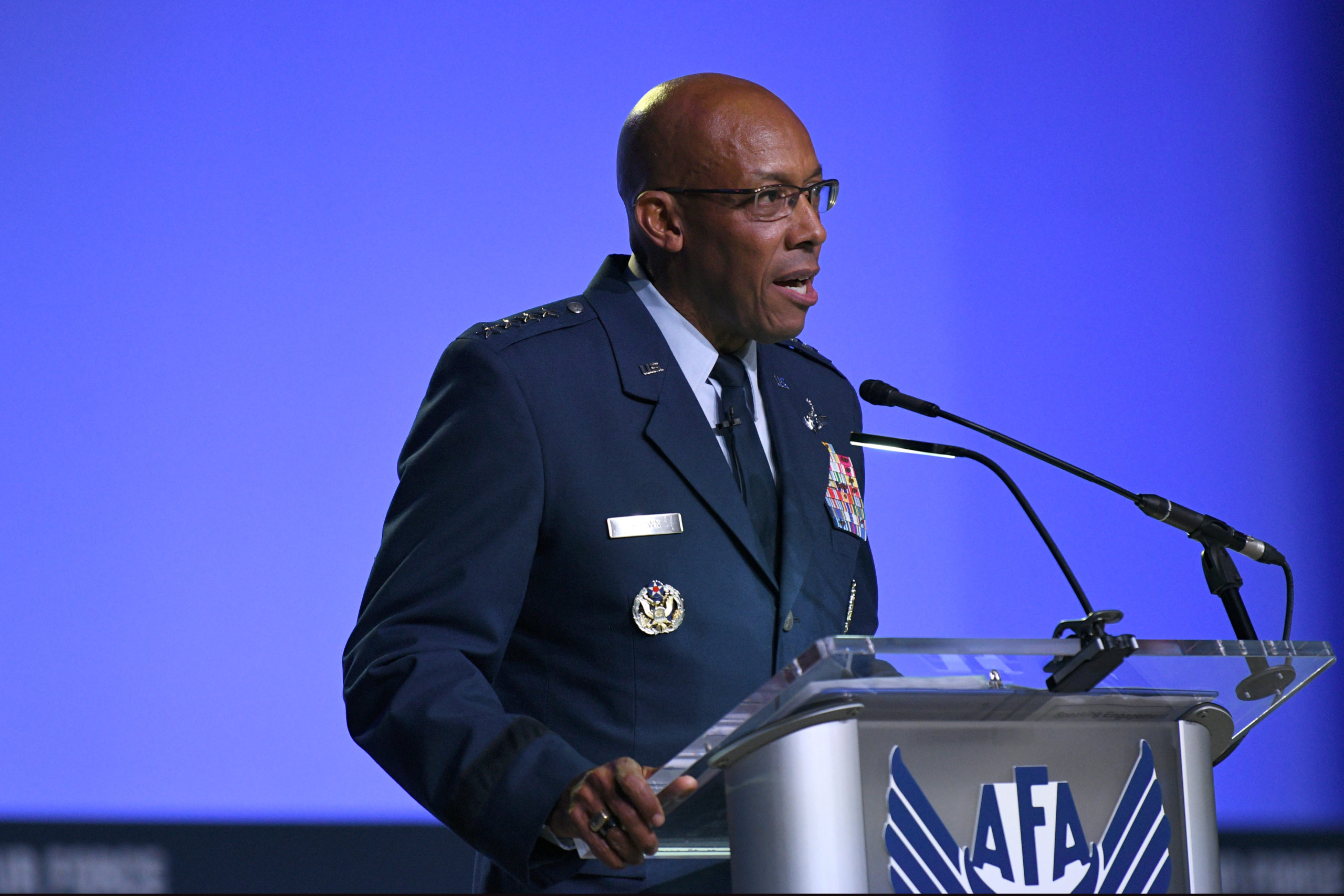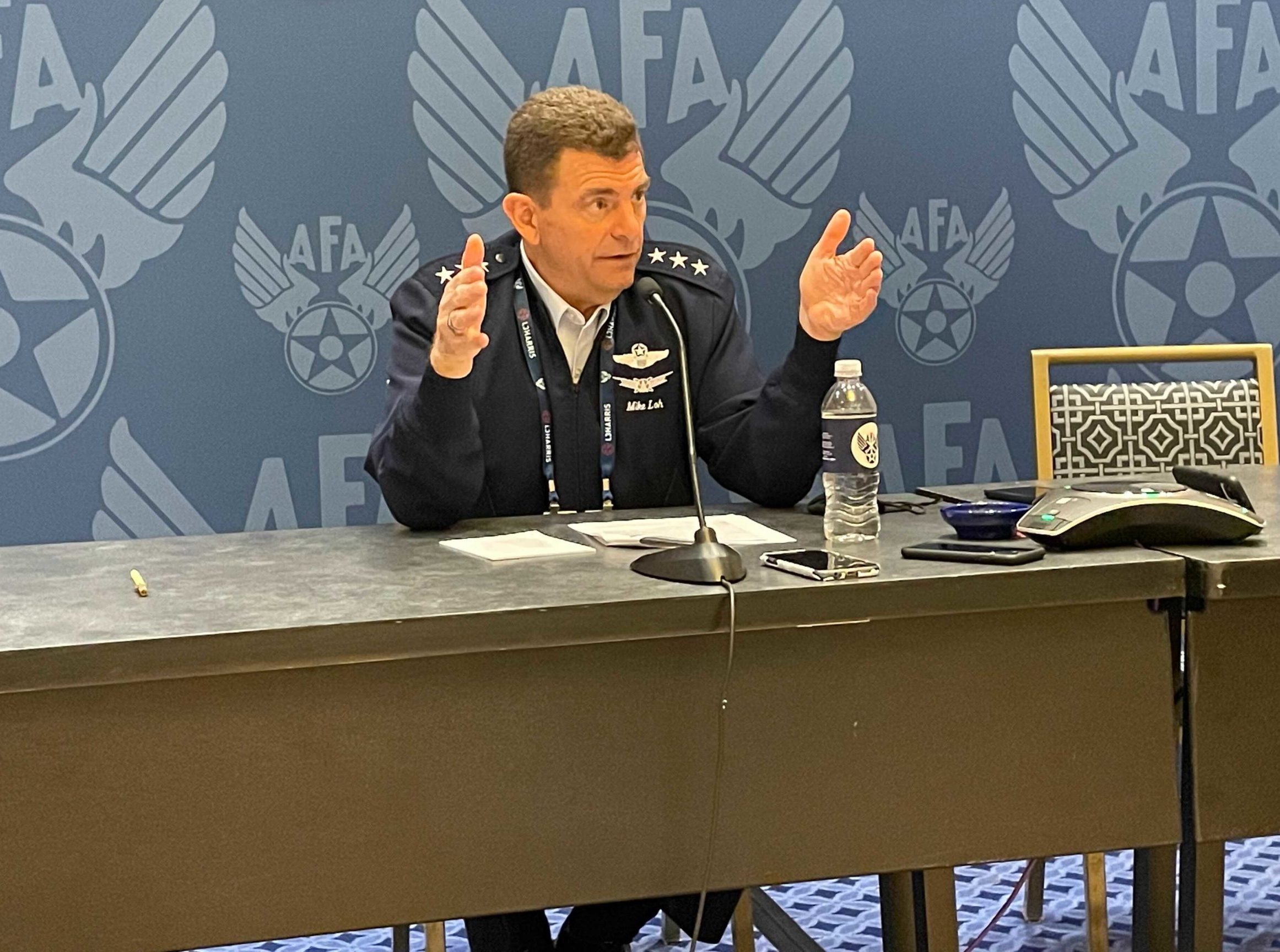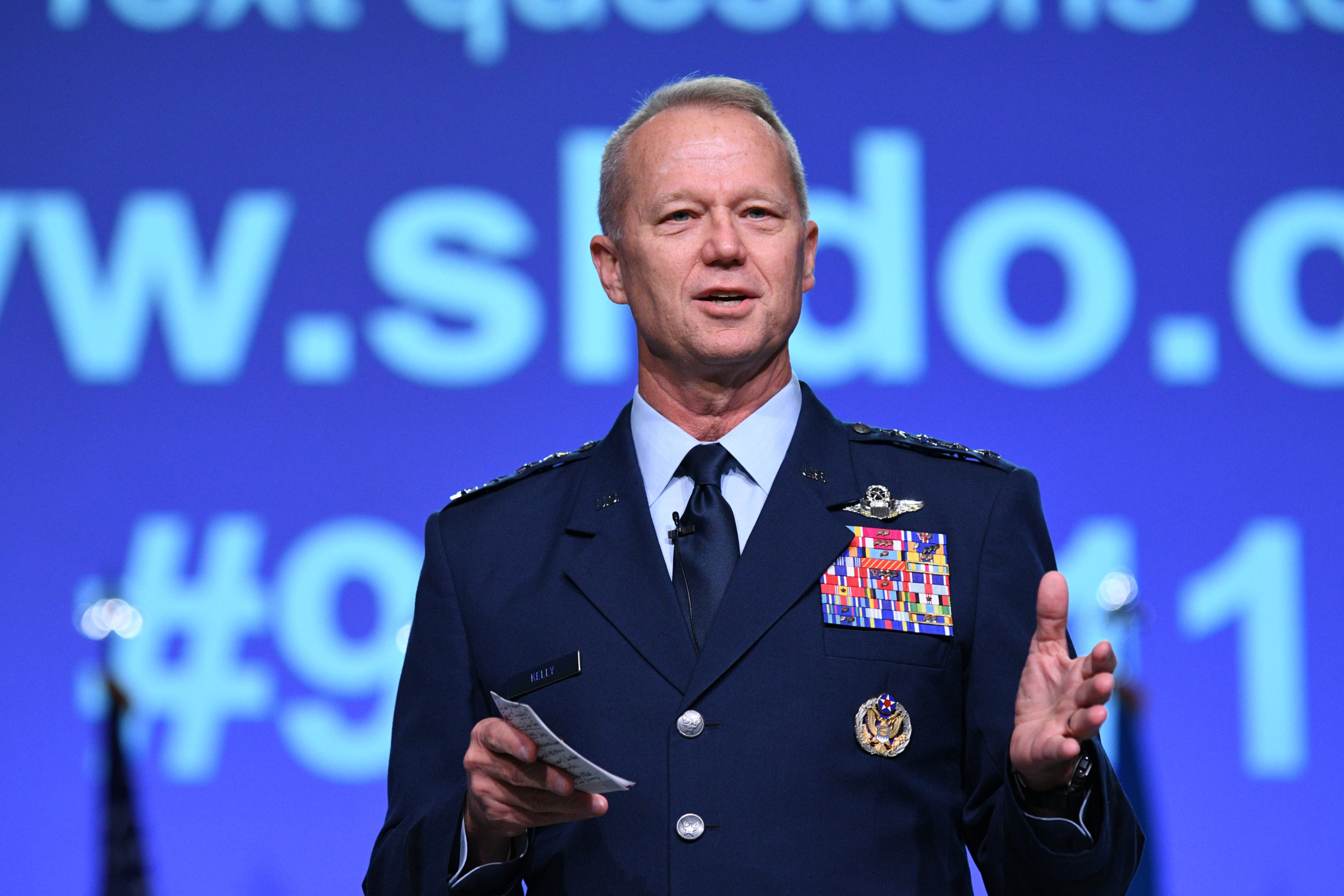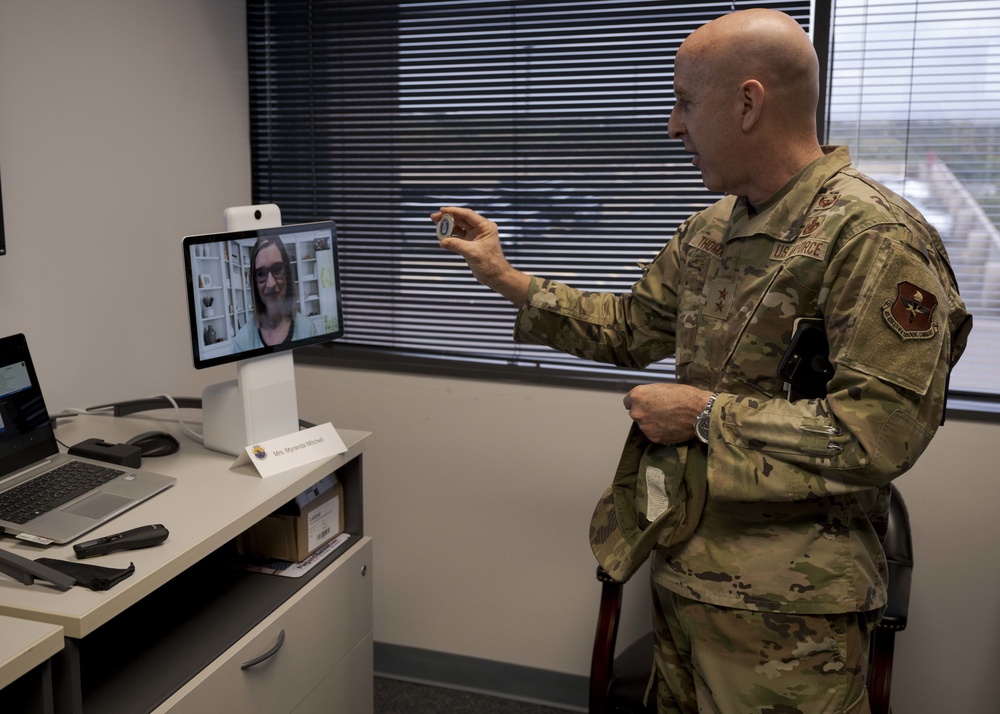Air Force Secretary Frank Kendall spoke at the Air Force Association’s Air, Space & Cyber Convention on Sept. 20, addressing a packed auditorium in National Harbor, Md. Here is a video and a transcript of his prepared remarks.
Good morning. I’m delighted to have the opportunity to speak to you this morning as your Secretary of the Air Force. I’ve been on the job almost two months…it’s been a pretty interesting start.
Let me begin by thanking the Air Force Association for working with me and the Department of the Air Force to put on this event, and to do so in a way that balances health risks and the value of coming together to discuss the current state and future of our Air and Space Forces.
Sadly, we are still contending with a disease that should have been well under control long ago. The tools exist to defeat that disease, but unfortunately those who have opted to spread or reinforce disinformation, instead of uniting our country around facts and serving the greater good, have kept us from being one team and from winning that fight – so far.
There’s a lesson for us all there somewhere isn’t there? President Biden routinely says that there is nothing, nothing Americans cannot do if they work together. He’s absolutely right, but when we don’t work together it becomes very hard if not impossible for us to prevail.
The person who was perhaps our wisest President once said “a house divided against itself cannot stand.” Our national motto, “E Pluribus Unum” echoes the same refrain. It would be beyond presumptuous by light years for me to compare myself to President Lincoln or the founding fathers, but the mantra I’ll be using in my new position, “One Team, One Fight”, which I expect you will get sick of hearing, is intended to send a very similar message.
I arrived two days before the proposed Department of the Air Force Fiscal Year 23 budget and five-year Future Years Defense Program plan was due to the Office of the Secretary of Defense.
With the approval of Deputy Secretary of Defense Hicks, I put my staff through an intense exercise to review and modify the Department of the Air Force’s proposed plan. The Air and Space Force staffs and the Department’s Secretariat responded very professionally and I’m deeply appreciative of the effort they put into supporting the review that Under Secretary Jones and I conducted. As part of that exercise I provided guidance to the staff, some of which I can share with you.
Now, for the industry representatives and reporters in the room and those watching virtually, please don’t get too excited – I won’t be discussing any specifics about this pre-decisional submission to the Office of the Secretary of Defense. What I can tell you is that the final Department of the Air Force Program Objective Memorandum was compliant with the guidance we had been given by the Secretary, and that it was focused on acquiring capabilities that will improve our posture against the pacing threat, which in case you haven’t been paying attention, is China.
I can also tell you that this submission to the Office of the Secretary of Defense, for their program and budget review, did not comply with every piece of direction the Department of the Air Force has ever been given by Congress, which seems to have some very strong views on the importance of retaining aircraft that we no longer need and that do not intimidate China. The costs of these aircraft are consuming precious resources we do need for modernization.
I also arrived approximately one month before America’s Air Force, with no lead time, was asked to execute the largest evacuation of people in US history. I will confess that I was more an awed observer than contributor to that mission, but I cannot say enough about the remarkable accomplishments of the Total Force Airmen and Guardians who were involved in this amazing feat.
While we did not foresee the speed and completeness of the collapse of the Afghan Army, we did demonstrate the strength, capacity, and professionalism to react immediately and to pull off massive operations with no notice. It is a big mistake to underestimate the power and capability of the United States’ Air and Space Forces.
Our operations, which you will hear a lot more about during the conference, included the airlift itself, of course, but also the movement of our ground forces into and out of Kabul, continuous surveillance from Space and the Air, overhead protection of our teammates on the ground, and simultaneously the establishment of housing and support for thousands of Afghans fleeing the Taliban and transiting to our bases in the region, to countries around the world, and also into the United States.
Noncombatant Evacuation Operations like this and force disengagements in hostile territory are extremely challenging and risky military operations. Our “one team” performed fantastically. Let’s give that team a roaring round of applause.
There is a lesson from the fall of Afghanistan to the Taliban that we as Americans, and we as Airmen and Guardians, should not miss. Historians and policy analysts will be trying to sort out what happened and why, after 20 years of American and allied support, the Afghan government fell so quickly.
One thing, however, is painfully clear: The Afghan government and military were not “one team” they were not engaged in “one fight.” Even when faced with an existential threat to their freedom, they could not overcome their internal divisions and unite against a common enemy. As a direct result, the people of Afghanistan have lost their freedom.
Today, America and its allies are faced with a less direct or immediate, but nevertheless equally serious, competitor. Since 2010, I have been pounding the drum about how serious a threat The People’s Republic of China’s military modernization program is to the ability of the United States to project power into the Indo Pacific, and more broadly our ability to protect our interests and values around the world.
The competition aspect of our relationship with China is strategic; it is not just about military power. But as Chairman Mao and many others have mentioned, military power is the basis upon which other elements of strategy depend.
Way back in 2010, I came back to government after spending fifteen years in industry. When I saw the intelligence on China’s military modernization program it was eminently clear to me that China was well down the road of acquiring specific capabilities designed to defeat the United States’ ability to project power into the region, into the Western Pacific.
The desire to contribute to America’s response to this rapidly growing threat is what has brought me back to the Pentagon for my third tour of duty. And once again, this time after a four year interval, I have had the opportunity to catch up on the intelligence about China’s modernization programs. If anything, China has accelerated its pace of modernization, and taken it in some disturbing directions.
The press has recently reported on China’s expansion of its nuclear arsenal. For decades China maintained a small nuclear force that was clearly intended to be a minimal deterrent and a second strike capability. In my view this was a wise and prudent policy. It provided China with more than adequate deterrence and it kept the risk of unintended nuclear use very low. There is now strong evidence that this approach has changed and that China is pursuing a significantly expanded inventory of nuclear weapons, especially silo-based ICBMs, as publicly available information does demonstrate.
Whether intended or not, China is acquiring a first strike capability. No one could rationally desire or plan to initiate a nuclear war, and I’m convinced that China does not. But as a person who grew up during the Cold War, and served in the military for the last twenty years of it, I saw the world come far too close to nuclear exchanges between the Soviet Union and the United States, and I am deeply concerned about the implications of China’s change in policy for nuclear stability and the potential for a catastrophic mistake.
China also continues to advance its conventional capabilities. While there are a number of areas in which the US maintains strong leads, China has invested smartly in Anti-Access Area Denial systems designed to defeat US power projection. First on this list are precision weapons of steadily increasing range. For about 20 years, I’ve watched the range and target set for these weapons, their sophistication, and their inventories, increase.
They have now gone from a few hundred miles to thousands to literally around the globe. They have gone from a few high value assets near China’s shores to the second and third island chains, and most recently to intercontinental ranges and even to the potential for global strikes…strikes from space even. Their addressable conventional target set has expanded from aircraft carriers, air bases, and logistic nodes in their near abroad… to American and allied high value assets located anywhere on the planet and anywhere in space.
Simultaneously, China is increasing inventory levels and the sophistication of their weapons and modernizing centers and command and control networks throughout the kill chains that support their weapons. Hypersonic weapons, a full range of anti-satellite systems, plus cyber, electronic warfare, and challenging air to air missiles are all part of the growing inventory of Chinese capabilities.
Several years ago I briefed the National Security Advisor Susan Rice on China’s military modernization programs. My short summary for her was “America is the dominant military power on the planet, but when one gets close to the shores of China this starts to change.” While America is still the dominant military power on the planet, we are being more effectively challenged militarily today than at any…any other time in our history.
I will tell you something few political appointees will admit – I worked hard to get this specific job. I did so despite having been an Army officer and a West Point graduate, and despite being an avid sailor and having a father who served on US Navy destroyers throughout WW II. If our “one team”, America and its allies, is going to win the “one fight” to keep our freedom, it will be because of the success of our Air and Space Forces, and that’s why I’m standing here speaking to you today.
Our sister services will contribute much to any fight; they bring formidable capabilities to any battlefield or campaign, and I don’t mean to disparage them at all, but without control of space and the air, their missions become all but unexecutable.
Only the Air and Space Forces have the ability to control the global high ground. Only the Air and Space Forces can project power on short notice to anywhere that it is needed. Only the Air and Space Forces have the ability to confront and defeat aggression immediately, wherever it occurs. Only the Air and Space Forces have the ability to come to the aid of our global allies and partners with little or no notice wherever aggression occurs.
So what are my intentions now that I have this job? At breakfast on Capitol Hill shortly after I was sworn in, I was asked by Senator Jon Tester what my priorities were. My answer, which was a little bit glib, was that I had three; China, China, and China. He seemed to like the answer and gave me a fist bump. And by the way if you’ve ever gotten a fist bump from Jon Tester, you’ll remember it. He’s a pretty big guy.
It isn’t quite that simple, however. I also resonate completely with Chief of Staff CQ Brown’s dictate “Accelerate Change or Lose.” Chief of Space Operations Jay Raymond has also articulated a clear list of five priorities for the Space Force, with which I am in full agreement. At a high level, however, I could not top Secretary Austin’s triumvirate of “mission, people, teams” which he stated elegantly and clearly in his March 2021 memo.
The Department of the Air Force exists for a purpose; to provide conventional and strategic forces to combatant commanders that will enable them to deter and defeat aggression, now and for the foreseeable future. The mission is bigger than any of us, and it is what unites us in service to the nation and defense of the American republic and its Constitution.
My most fundamental priority is to improve the ability of the Air and Space Forces to deter and defeat our pacing threats so that when I leave office we are stronger, and will continue to be stronger than those threats, well into the future.
To be stronger we are going to have to change. Our strategic competitors have studied how we fight and they have taken asymmetric steps to exploit our vulnerabilities and to defeat us. We have to respond with a sense of urgency, but we also have to take the time necessary to make smart choices about our future and our investments.
One observation from this Cold War veteran is that today we are not accustomed to contending with a capable peer competitor. Even our most senior military leaders have little-to-no experience dealing with a peer competitor.
We have had 30 years of unprecedented military superiority and we have lost much of our “muscle memory” of what it means to have a well-resourced, thoughtful, and strategic opponent. We have also been focused on a category of threat, violent extremists, which demand a very different set of capabilities from a peer competitor.
We need a strong sense of urgency, but change for change’s sake isn’t the answer. If we don’t get the direction of change right, our actions will be counterproductive and we will continue to squander our most precious resource, time.
We also live in an era of dramatically expanding technical knowledge. To get change right we must improve our ability to analyze and understand the operational possibilities that technology is providing. We must be open-minded and objective about the operational doors that technologies like autonomy, artificial intelligence, advanced micro-electronics, data analytics, and others can open for us.
My observation from outside of government for the last few years is that the Departments of Defense, and of the Air Force, have embraced the idea of innovation and the pursuit of innovation without adequate attention to how innovation should be harnessed to specific operational performance requirements.
We should not be doing demonstrations and experiments unless we can link them to true operational improvements and unless they move us down the field to lower-risk acquisition programs. I intend to strengthen these linkages and to use state-of-the-art analytical tools to help do so.
A case in point is the Advanced Battle Management System, or ABMS, the Department of the Air Force’s component of Joint All Domain Command and Control. My early observation is that this program has not been adequately focused on achieving and fielding specific measurable improvements in operational outcomes.
To achieve effective change we must keep our eye on the ball. For me that means focusing on the fielding of meaningful military capability into the hands of our operational users. It does not mean one or two leave-behind unmaintainable token prototypes that came out of an experiment. I am all for meaningful experimentation and prototyping if it leads efficiently to sound decisions about risk and value, and to real military capability.
One case in point here is the Air Force’s Next Generation Air Dominance program. The roots of this program are in a technology demonstration program from the Obama Administration that I initiated called the Aerospace Innovation Initiative. This program was put on contract with industry in 2016. That classified but acknowledged program has demonstrated key technologies in an experimental risk reduction prototype that is directly on the path to Next Generation Air Dominance.
Next Generation Air Dominance is more than just a next-generation tactical aircraft however; it is a coordinated systems-of-systems approach to air dominance. Those roots go back even further, to the Air Dominance Initiative study.
A more mature example of programs leading to real military capability is the B-21 Raider, which will become the backbone of the Air Force bomber fleet. The B-21 had its origins in an extensive “family of systems” study that was led by Ash Carter early in the Obama Administration. Most of you in the audience know that our allied partners do not own or operate long range bombers, and that the US hasn’t had an active bomber production line in over 20 years.
We have been living off of bomber fleet investments made many decades ago, but that is rapidly changing. As I speak here there are now 5 test aircraft being manufactured on the B-21 production line at Air Force Plant 42 in Palmdale.
You will never hear me make optimistic predictions about programs; all programs have risk and the same is true of the B-21, but at this point at least, the program is making good progress to field real capability. This investment in meaningful military capabilities that project power and hold targets at risk anywhere in the world addresses my number one priority.
Another recent, smaller example is in the field of artificial intelligence and data analytics. This year the Chief Architect’s Office deployed AI algorithms for the first time to a live, operational kill-chain at the Distributed Common Ground Station and Air Operations Center for automated target recognition. In this case, moving from experimentation to real military capability in the hands of operational warfighters significantly reduced the manpower-intensive task of manually identifying individual targets, shortening the kill-chain and accelerating the speed of decision making.
As a final example, the Space Force is pursuing a space-based ground moving target indicator capability, or GMTI. The space-based GMTI system will replace a portion of the JSTARS sensing capability. It will surpass the range limitations of current air platforms, and will provide resilient capabilities in both contested and non-contested environments.
I will be looking for other opportunities to rapidly and efficiently move the applications of advanced technology, from any source, down the field as quickly as possible to get meaningful military capabilities into the hands of our operators.
No mission can be performed without skilled and dedicated people. When the mission is daunting and must be performed with urgency, this is especially true. The challenges the Department of the Air Force faces can only be met if we attract America’s best to serve, and give these people the opportunity and environment in which they can make the greatest contribution they are capable of. I couldn’t be more proud of the people who are currently serving in the Air and Space Forces, not just as Department Secretary, but as an American citizen. I’ve had quite a few chances to meet with Airmen and Guardians over the last two months.
I’ve made the time to travel to INDO-PACOM, SPACECOM, NORTHCOM, and STRATCOM, and to meet the Airmen and Guardians serving in these Combatant Commands and their associated Component Commands. Just a week ago I had the opportunity to be with the Air Force Academy cadets as they beat Navy in football. Go Falcons!
I’m especially looking forward to being at the Army/Air Force game this year. By the way it’s my West Point 50 year anniversary reunion, which will make it quite an interesting weekend. I’m looking forward to traveling to other major commands soon and meeting with more of the professional men and women who are serving their country with such dedication and commitment.
High on my list are the people of Air Mobility Command who just pulled off such an amazing feat, as well as the Airmen at Holloman AFB, Joint Base McGuire-Dix-Lakehurst, and those serving overseas who are doing such a fine job supporting the Afghan people we evacuated from Kabul.
I intend to be relentless in supporting our Airmen, Guardians, Civil Servants, and their families across the Total Force. I am committed to seeing that they have what they need to be successful. I’m also aware, however, that we have some areas where change here is needed here as well.
Just recently, I released two reports dealing with disparity in our ranks. The data is very clear that we are not doing as well as we should be in ensuring that every Airman and Guardian has the opportunity to achieve their full potential, and can—to the full extent of their capability—contribute to our team and to our shared missions.
There is significant disparity in almost every aspect of the Air Force experience between the outcomes and the perceptions in areas such as promotions, law enforcement, sexual harassment, and assignments between members of less well represented groups and the white male majority. One notable perception gap is between a majority that generally thinks things are fine, and everyone else where there is a strong perception that it is not all fine.
Disturbingly, one-third of female Airmen and Guardians who responded to the Inspector General’s survey for the disparity review reported experiencing sexual harassment during their career. Almost every morning I learn of incidents in which we have lost someone to suicide, in accidents, or to COVID. We cannot just accept these situations and losses. We must look for every opportunity to improve.
There was also a recent report in the media of instances where domestic abuse involving our people was not treated with the concern and seriousness with which any such incident should be treated. We can do much more to prevent these crimes, and we can certainly respond more effectively and compassionately whenever they occur.
My intent is to actively address each of these issues. There are some programs already ongoing in each of these areas. The Department has not ignored them by any means, but I believe we can do better.
With regard to disparity, we have more than enough data to begin working to address the disparities that we know exist. In some areas, we need to refine our understanding of potential contributing causes, but we don’t have to wait to start acting. Over 100K of our Airmen and Guardians responded to the latest survey in that review—I read that as they trusted us to act. And that is exactly what we should do.
In some areas, such as the disparity in perceptions between white males and everyone else about the existence of disparate treatment, – news flash – it does exist, the data isn’t ambiguous about that.
For sexual assault and harassment, we will be implementing the Independent Review Commission’s recommendations and any statutory guidance regarding separate reporting and prosecution channels that comes out of the Congress this fall. I intend for the Department of the Air Force to be ready to implement that guidance immediately once it becomes law.
I want to take a moment to recognize that today marks 10 years since the DoD stopped enforcing Don’t Ask, Don’t Tell. While LGBTQ Airmen have been serving honorably and courageously since the first days of the Air Force, for too long they had to so do while hiding a key part of themselves, of their identity. We’re a stronger Department of the Air Force—we’re a stronger country—because that discriminatory policy no longer exists.
As I speak, Under Secretary Jones, who is the living embodiment of the importance for changing that policy, is attending a White House meeting commemorating this event.
Another area of particular concern to me is that the Air Force and Space Force have the people with the technical expertise needed to prevail against the pacing threat (yes, China). I particularly noticed the great round of applause that recognized the teacher this morning. Her efforts on STEM are really to be admired. We really need more of that, and I thank her for her contributions and all the other teachers out there who are doing the same sort of thing. Our strategic competition is as much about intellectual capacity in critical technologies, engineering expertise, and the application of cutting edge cybersecurity technology as it is about flying skills and tactics. I will be looking for creative ways to bring more of the needed expertise and potential into the Department and to keep it there.
If pacing strategic competitors are the “one fight” we must be ready for, there are a number of valid interpretations of the “one team” part of the mantra I’m employing. Within the Department of the Air Force it applies to the shared services that the Air Force is supplying to the Space Force, as well as to the integration of Air and Space operational capabilities.
As a Joint team member, the Space Force provides and defends a number of capabilities used by all the other Services. As I mentioned, we will be moving forward with new services such as Ground and Surface Moving Target Indicator capabilities from space, and we will be moving to more resilient space architectures in general so that our Joint teammates can be assured of the support they have come to depend on from space and from the Department of the Air Force.
As a Joint team member, the Air Force provides surveillance, control of the air, air mobility services, all that enable the other terrestrial Services to perform their missions. To this end we will continue to modernize our tanker fleet, provide the air mobility services all combatant commanders depend upon, and transition to more resilient surveillance capabilities that are applicable to high-end threats.
We will also be working with other parts of the US Government and with our friends and allies around the world to integrate and improve our combined capabilities as we all contribute to what Secretary Austin has dubbed “integrated deterrence.”
One of my observations after spending a few years working with defense contractors, private industry, and non-profit organizations, is that the Department of the Air Force isn’t taking enough advantage of the intellectual capital and expertise available from these sources.
While there has been a lot of emphasis on new sources of technology from places like Silicon Valley, certainly a worthy initiative, there has not been enough effort to tap into the capabilities that exist in both major defense contractors and defense-oriented non-profit organizations.
That intellectual capital is formidable, it is more cutting edge than many may realize, and it is well-positioned to attack and help solve our operational problems which those communities do understand very well. We will be doing more to bring these capabilities on to the team to help us address our most pressing operational requirements.
Effective change also means close and constructive cooperation between operational and technical communities operating as “one team.” It’s commonplace in the commercial world for customers and product developers to work closely together in integrated teams. Within the Department of the Air Force I will be insisting on that cooperation and I will do everything I can to bring the same approach to our shared joint capabilities.
I would be remiss if I did not mention another member of our “one team,” the United States Congress. I have one request of the Congress; help us to focus on the one fight, the strategic competitive fight, that we must win.
Let me give all of you a fictional headline to imagine; “Today in Hunan province the ranking delegate to the Chinese National People’s Congress announced that he would oppose the retirement of 10 aging J-10 fighters based in Hunan. Those fighters are critical to the defense of China and should not be retired until they are replaced by new J-20s.” Can any of you imagine that headline in the South China Morning Post? I cannot.
Our democracy and our values are a great strategic advantage; they make the United States an attractive partner, but all politics are local and our local politics can be counterproductive to national security.
It was a frequent occurrence during my confirmation process to have a Senator agree with me about the significance of the Chinese threat, and in the same breath to tell me that under no circumstances could the -take your pick – C-130s, A-10s, KC-10s, or MQ-9s in that Senator’s state be retired, nor could any base in his or her state ever be closed or lose manpower that have an impact on the local economy.
We will not succeed against a well-resourced and strategic competitor if we insist on keeping every legacy system we have. Our one team cannot win its one fight to deter China or Russia without the resources we need and a willingness to balance risk today to avoid much greater risk in the future. I do understand the political constraints here, and I’m happy to work with Congress to find a better mechanism to make the changes we need, but we must move forward.
As I did several years ago, I will be soon seen on Capitol Hill carrying a classified briefing on the current and emerging threats we face. If anyone wants to see that briefing, please let me know. When you see the specifics, I think it will make you open your eyes.
Several years ago my message to members of Congress, and to anyone who would listen, was that we were running out of time; today we are out of time. In the words of one of my favorite fiction writer’s protagonist from another era of strategic competition, “There is not a moment to lose.”
While we are at this conference, and after we leave it, we should be proud of what we do every day and what we have done recently in Afghanistan, globally, and in space. But we should not be complacent, anything but. We must all continue our work with the sense of urgency that it demands. One team, one fight. Thank you.
